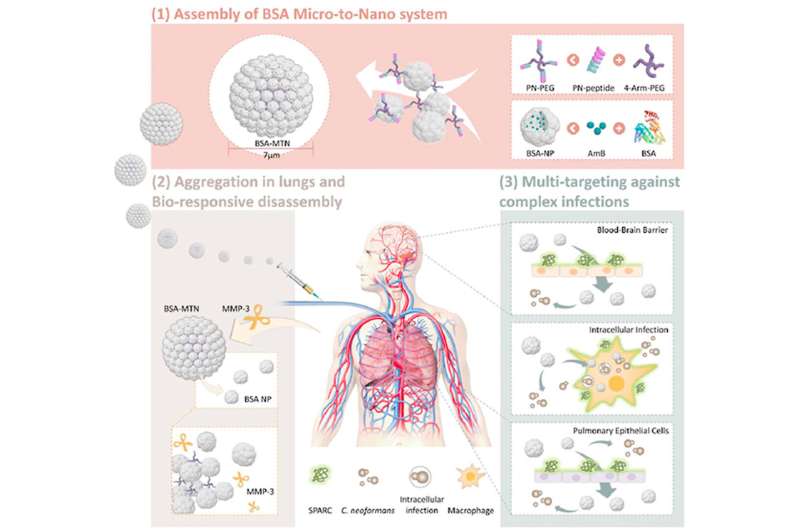
As a typical human pathogenic fungus, Cryptococcus neoformansis a life-threatening invasive fungal pathogen with a worldwide distribution causing ∼700,000 deaths annually. Cryptococcosis is not just an infection with multi-organ involvement, intracellular survival and extracellular multiplication of the fungus also play important roles in the pathogenesis of C. neoformansinfections. Because adequate accumulation of drugs at target organs and cells is still difficult to achieve, an effective delivery strategy is desperately required to treat these infections.
In this article the authors report a bioresponsive micro-to-nano (MTN) system that effectively clears the C. neoformans in vivo. This strategy is based on the authors in-depth study of the overexpression of matrix metalloproteinase 3 (MMP-3) in infectious microenvironments (IMEs) and secreted protein acidic and rich in cysteine (SPARC) in several associated target cells. In this MTN system, bovine serum albumin (BSA, a natural ligand of SPARC) was used for the preparation of nanoparticles (NPs), and then microspheres were constructed by conjugation with a special linker, which mainly consisted of a BSA-binding peptide and an MMP-3-responsive peptide. This MTN system was mechanically captured by the smallest capillaries of the lungs after intravenous injection, and then hydrolyzed into BSA NPs by MMP-3 in the IMEs. The NPs further targeted the lung tissue, brain and infected macrophages based on the overexpression of SPARC, reaching multiple targets and achieving efficient treatment.
The authors have developed a size-tunable strategy where microspheres “shrink” to NPs in IMEs, which effectively combines active and passive targeting and may be especially powerful in the fight against complex fungal infections.
More information:
Liting Cheng et al, Bioresponsive micro-to-nano albumin-based systems for targeted drug delivery against complex fungal infections, Acta Pharmaceutica Sinica B (2021). DOI: 10.1016/j.apsb.2021.04.020
Provided by
Compuscript Ltd

READ MORE
9 Things You Didn’t Know Were Named After People
© Evgeniyaphotography-iStock/Getty Images The etymology of words can be complicated. In English many words derive [...]
Nanopore sequencing and DNA barcoding method gives hope of personalized medicine
Illustration of a nanopore reading a DNA sequence and converting it into an electrical signal. [...]
Using Amber-Filtered Bulbs Instead of White Light Attracts Fewer Bugs
As many commercial operators and homeowners are shifting to LEDs, which tend to fall somewhere [...]
How Much Do Flies Help With Pollination?
A blowfly on lavender flowers. Flies are the unsung heroes of pollination. They visit flowers [...]
The Gullah Geechee Tradition of ‘Haint Blue’ Paint Keeps the Spirits Away
If you wander through coastal Georgia and South Carolina, expect to see porch ceilings painted [...]
What Is the Rosetta Stone and Why Is the Artifact Important?
Getty Images Ancient Egypt conjures up images of bearded pharaohs, mighty pyramids and gold-laden tombs. [...]
Nanoneedle breakthrough gives hope for cheaper cancer treatment
Grpahical abstract. Credit: Materials Today (2023). DOI: 10.1016/j.mattod.2023.02.009 Australian scientists have successfully found a way [...]
How do hybrids utilize eco-plastics?
The seat cushions for the Lexus HS 250h contain eco-plastic. See more pictures of hybrid [...]